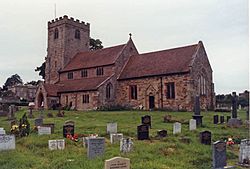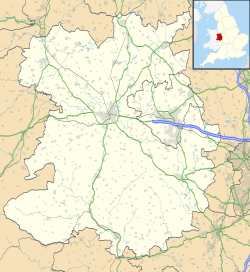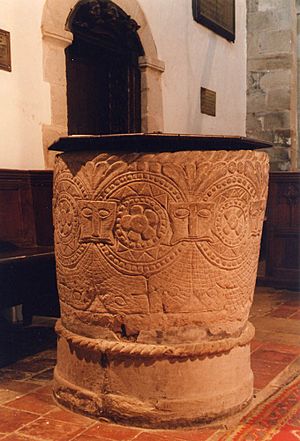Morville Priory facts for kids

St Gregory's church, Morville, once the centre of a very large parish and the church to which the priory was attached.
|
|
| Monastery information | |
|---|---|
| Order | Benedictine |
| Established | 1138 |
| Disestablished | 1540 |
| Mother house | Shrewsbury Abbey |
| Dedicated to | Gregory the Great |
| Diocese | Hereford |
| Controlled churches | Billingsley Oldbury Tasley Aston Eyre Astley Abbotts |
| Site | |
| Coordinates | 52°32′31″N 2°29′19″W / 52.5419°N 2.4886°W |
| Website | St Gregory the Great, Morville, at achurchnearyou.com |
Morville Priory was a small Benedictine monastery in Shropshire, England. It was like a smaller branch, or "cell," of the larger Shrewsbury Abbey. Monasteries were places where monks lived and prayed together, often helping the local community.
Contents
Where Was Morville Priory?
Today, Morville is a small village, or hamlet. It sits on the road between Bridgnorth and Much Wenlock. A famous building there is Morville Hall, which is now looked after by the National Trust.
The priory itself was located right next to the local church. This church is still there today, just east of Morville Hall. In the old Domesday Book from 1087, Morville was called Membrefelde. It was the main place, or caput, of the Alnodestreu area. It was quite a big settlement for its time, with at least 22 families living there. Unlike Shrewsbury Abbey, Morville was, and still is, part of the Diocese of Hereford, which is a church district.
How Morville Priory Started
The story of Morville Priory begins with an older church in the area. Before the Normans came to England in 1066, there was a special church at Morville. It was called a minster and was dedicated to St Gregory. Eight canons, who were a type of priest, served this church. They were supported by land, possibly divided among them.
After the Norman Conquest, the church lands came under the control of Roger de Montgomery. He was the Earl of Shrewsbury. He gave some of the land to his own chaplains (priests). Later, between 1083 and 1087, he gave the entire church to Shrewsbury Abbey. He said that as the canons died or left, their land should go back to the abbey.
The Domesday Book in 1087 showed Morville as a large settlement. It had 25 families of villeins (farmers who worked for a lord), 7 smallholders, and 2 slaves. Shrewsbury Abbey now owned five areas of land (called hides). Earl Roger's chaplains still held three hides, with five men working that land for them. Morville was the only church mentioned in its area in the Domesday Book. This suggests that the whole area was one large church parish.
Getting the church lands back for Shrewsbury Abbey was not easy. In the early 1100s, one of the chaplains, Richard de Mesnilhermer, died. Even though he had become a monk of Shrewsbury before he died, his son Hubert claimed his father's land. King Henry I ordered Richard de Belmeis I, who was a bishop and also in charge of the Welsh Marches (border lands), to hear the case. The abbey won the case.
Now, Shrewsbury Abbey was fully responsible for the church at Morville. They had to make sure worship happened there. In 1118, the church was rebuilt and rededicated by Geoffrey de Clive, the Bishop of Hereford. A old story tells of a sad event that happened after the church was rededicated:
| Ecclesia apud Momerfeld a Gosfrido Herefordensi episcopo dedicata, omnes qui ad dedicationem venerant, domum redibant; verum post aeris serenitatem, quae prius extiterat maxima, repente cum tonitru orta est tempestas nimia, qua perculsi quidam in itinere, dum loco in quem devenerant cedere non valerent, subsistebant. Erant numero quinque, tres viri et duae foeminae, quarum una ictu fulmineo percussa occubuit, altera vero ab umbilico usque ad pedum vestigia misere percussa et ignita decidit, viris duntaxat vix vitae reservatis. Quinque etiam caballi illorum fulmine perculsi interierunt. | After the church of Momerfield was dedicated by Geoffrey, Bishop of Hereford, everyone who had come for the dedication went home. But even though the weather had been very calm, a strong storm with thunder and lightning suddenly started. Some people on the road were caught in it and couldn't move from where they were. There were five of them: three men and two women. One of the women was killed by a lightning strike. The other woman was badly burned from her belly to her feet and died. The men barely survived. Their five horses were also struck by lightning and died. |
The church officially became a priory in 1138. This happened when Shrewsbury Abbey "appropriated" it. This meant the abbey could take the yearly tithes (a portion of income or produce) from the church. Bishop Robert de Bethune allowed this in 1138. He felt the abbey needed the money to serve the parish. He also said that a group of monks from Shrewsbury should live at Morville. These monks could be changed by the Abbot of Shrewsbury. The priory also had to offer "hospitality" (a place to stay) for the Bishop of Hereford. This meant they had to have staff for food and cleaning when needed.
Life and Work at the Priory
Over time, the different areas within the large Morville parish started to get their own small chapels. Some of these chapels even became their own parish churches. This made the Morville parish smaller and easier to manage, so fewer monks were needed.
Besides its own land, Morville church brought other small incomes to Shrewsbury Abbey. For example, it received money from the chapels of Billingsley and Oldbury, and from Tasley chapel. The right to appoint the priest (called the advowson) for the chapel at Aston Eyre was fought over. Shrewsbury Abbey won this right around 1190. This brought in more money each year. Later, this chapel was fully joined with Morville. The chapel at Astley Abbotts was also joined around 1219, specifically to help with the hospitality at Morville. However, most of these incomes went straight to Shrewsbury Abbey. Only very small amounts went directly to Morville Priory. For example, in the mid-1200s, a widow named Sibil of Haughton gave 15 pence each year to the priory. Of this, 2 pence had to be used for lighting in the church.
Shrewsbury Abbey not only took the money, but also chose the prior (the head monk) at Morville. The priory was not independent. It was a full part of the Shrewsbury Abbey community. The priors of Morville were active in the abbey's business. For example, in 1220, John, the first prior of Morville we know by name, helped the abbot with a property case. In 1460, William Ball, who was prior, took part in choosing a new abbot for Shrewsbury.
It seems there were never more than two or three monks living at Morville Priory. In one case, a prior named John Wallensis was accused of bringing part of a deer into the priory illegally. But he died before the case could be heard in court. By 1372, the prior was the only monk there. He mainly acted as a local manager for the abbot. He collected rents and tithes, and looked after the smaller chapels.
However, the priory did work well as a guest house for the bishops. But the bishops had to pay for their stay. Bishop Richard Swinefield's old expense records show he stayed at Morville on April 20, 1290. He and his group had 35 horses, which needed oats and hay. They themselves ate chicken and pork.
The Priory's End
Morville Priory seemed to get smaller in the last years of Shrewsbury Abbey. It was often just called a grange, which is like a farm managed by a monastery. In 1518 and 1521, the prior was the only monk living there.
Richard Baker, also known as Marshall, was the abbot of Shrewsbury. He stepped down in December 1528 and moved to Morville. He became the prior there the next year. He stayed until the Dissolution of the Monasteries in 1540. This was when King Henry VIII closed down all the monasteries in England.
Shrewsbury Abbey gave Richard Baker a pension (regular payment) of £40. To pay him, they gave him the priory itself, with all its lands and incomes. The priory remained his for life, even after the Dissolution. However, the right to own it after he died was given to John Dudley in 1545. A royal survey in July of that year said the priory's income was £30 0s. 9d. But after paying for things like the salaries of the local priests (called curates) in Morville and Wheaton Aston, the actual value was much less, about £16 10s. 10¾d.
It seems Richard Baker did not actually live at Morville. He spent his later years in Bridgnorth, where he died in 1558. John Dudley later sold the right to own the priory after Baker's death to Roger Smyth of Bridgnorth.
Images for kids





